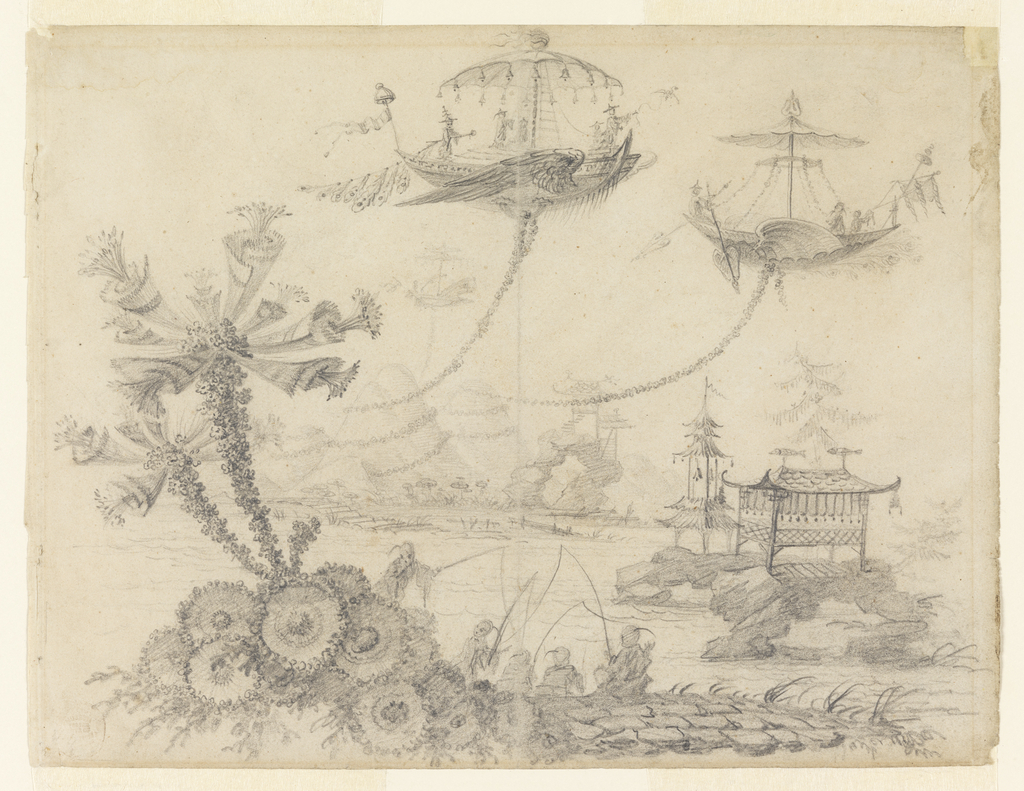Ships, precariously tethered to mountain tops by garlands, hover over a landscape of pure fantasy in this graphite drawing by the French artist Jean-Baptiste Pillement (1728-1808). Pillement was known for his imaginative prints featuring chinoiserie designs that were in essence European variants of Japanese and Chinese motifs. Pillement was a prolific artist who operated in the rococo style popular in the mid-eighteenth century. He worked widely in Spain, Austria, England, Portugal, Poland, Italy, and France, decorating royal palaces and aristocratic residences—later becoming the personal painter to Marie-Antoinette in 1778.
This landscape displays the influence of poetic Chinese literati paintings that were popular during the Southern Song dynasty. Instead of a pine or willow tree, Pillement has invented an alien plant composed of spirals, ovals, and cell-like shapes. A group of fishermen are seated by the fantastical tree. Suspended on rocky arches in the lake (or river) are two pagodas. Faintly outlined in the far background are more pagodas on grotto-like formations, a tilted pine tree and hazy mountain ranges. In the upper half of the sheet are two boats with Chinese parasols—one with eagle wings and the other with dragon wings. The floating boat is a machine aérostatique, and it may reflect a contemporaneous interest with aeronautics as popularized through Bartolomeu Lourenço de Gusmão, a Portuguese naturalist who experimented with airship designs in early 1700s.[1]
Curious plants and Chinese boats are common motifs in Pillement’s etchings. Pillement’s exploration of chinoiserie designs expanded upon the tradition of the grotesque explored byJean Berain and Claude III Audran. Chinoiserie designs were created by other artists such as Antoine Watteau, Francois Boucher, and Jean Revel. In fact, over the course of his long artistic career, Pillement’s chinoiserie designs were published in over fifty-three collections of more than 358 engravings and 950 prints. Although the design on this leaf from a sketchbook doesn’t appear to have been reproduced in print, many of the designer’s compositions were engraved in pattern books that were subsequently used widely by textile designers. Pillement’s inventions were adapted for wallpapers, porcelain, Japanned cabinet panels, tapestries, silk, printed cotton, snuff boxes and other decorative arts. Often they were combined with chinoiserie designs by other artists such as Francois Boucher.
This curious design then is a document of the cross-cultural connection between the East and the West, which included architecture, lacquer, ceramics and furniture types. Moreover, it offers a glimpse into the creative genius of a prolific eighteenth-century artist and designer. In fact Pillement noted in his Mémoire that he was “brought up in drawing” from an early age.
[1] First suggested by Michel N. Benisovich in “Quelques Artistes Francais au Portugal,” Gazette des Beaux-Arts 39 ( February 1952), p. 124.
Cabelle Ahn is a graduate intern in the Department of Drawings, Prints and Graphic Design at the Cooper Hewitt, Smithsonian Design Museum. She received her MA in Art History from the Courtauld Institute of Art and is currently studying eighteenth century decorative arts at the Bard Graduate Center.
